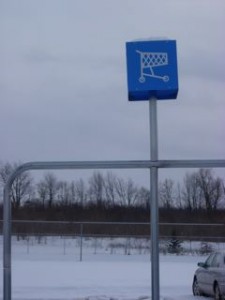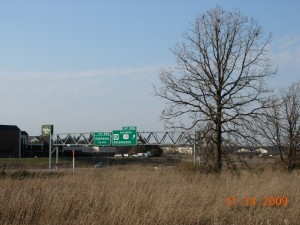
Bur Oak tree with US-131 in the background, early winter, Colony Farm Orchard. Photo by Richard Brewer.
The Michigan Senate passed HB 5207 Friday night 18 December, not long before adjournment. The bill goes to Governor Jennifer Granholm, who will sign it or veto it.
Curiously, WMU’s lobbyists did not inform the Kalamazoo Gazette that the bill had passed the Senate. When the bill passed the House in September, Greg Rosine was on the phone to the Gazette within minutes. Not until Sunday afternoon did the Gazette find out what had happened this time.
There were 30 Yeas and 1 Nay. The yeas were (Democratic Senators in boldface) Allen – Anderson – Gilbert – McManus – Sanborn – Birkholz – Gleason – Nofs – Scott – Bishop – Hardiman –Olshove – Stamas – Brown – Jacobs – Pappageorge – Switalski – Cassis – Jansen – Patterson – Thomas – Cherry – Kahn – Prusi – Van Woerkom – Clarke – Kuipers – Richardville – Whitmer – George
Cherry is Deb Cherry, Lt. Governor John Cherry’s sister.
Seven senators were excused and did not vote: Barcia – Basham – Clark-Coleman – Hunter – Jelinek – Brater – Garcia
The single nay was Alan Cropsey, a conservative Republican born in Paw Paw not far west of Kalamazoo, though now living in Dewitt and representing voters in that region. His protest over the vote is quoted below:
“Years ago when the land was first transferred to Western Michigan University, it was understood that the land would be used as a green space for that area. I think that Michigan State University actually had it in such a horticultural state that they were doing different studies and research for agriculture and fruit farming on that property. It was understood that it would remain a green space.
“I find it ironic that after a couple of decades that now the use is being changed dramatically. Green space is going away. I just want this body to know that at least there is one true ardent environmentalist left in this august body who is going to stand up and speak out for the plants and animals that are so desperately needed in our urban centers.”
WMU has advertised the bill as a way of creating jobs, and probably many of the senators voting yes took WMU at its word. The Senator from the Kalamazoo district (20th), Tom George, had made up his mind months ago, and the hundreds of messages he received from citizens didn’t change it. When interviewed by the Gazette on Sunday, he said, “I have to look at the big picture….Kalamazoo has another mechanism for attracting new jobs and growth.”
Other Senators, and Representatives before them, said much the same thing. Probably no politicians, or any of the rest of us, are against jobs. Many able and willing people are out of work in these hard times. That’s why it’s particularly disheartening that WMU’s claim that removing the open space/public use restriction will lead to job creation at the Colony Farm Orchard rests on such shaky grounds.
It’s hard to evaluate WMU’s statements about jobs created in the current BTR park because the university provides little supporting data. “No supporting data” comes closer. It is hard to tell, for example, how many of the current jobs among companies at the BTR were “created” by the park and how many were at employers that simply moved to the park from elsewhere in the region, or are new jobs but ones that would have ended up at some other site in the region except that the tax situation was better at a SmartZone site.
In his Gazette Viewpoint of 23 September 2009 President John M. Dunn stated that “more than 1300 jobs have been directly or indirectly created.” Numbers of jobs claimed by WMU fluctuate, but the usual quotes I’ve seen are 645-650 direct and 700 indirect.
In other words, the majority of the 1300+ jobs are indirect. There are various definitions of indirect jobs; roughly, they are new jobs outside the BTR park financed by money spent by park firms and their employees. As the Mackinac Center, a free-market think-tank in Midland, Michigan, has stated, “Estimating indirect job counts is a subjective exercise, and econometricians and accountants with the best of intentions can produce widely varying figures, depending on their assumptions and estimation techniques.”
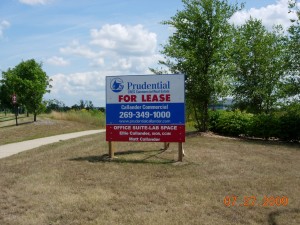
In the BTR Park, summer 2009. Photo by Richard Brewer.
But all this is nearly irrelevant because, although WMU uses the job creation claim as justification for removing the Colony Farm Orchard’s protective covenant, WMU has repeatedly said that nothing is going to happen at the Orchard site soon. Most statements have said that the reason for removing the restriction is so that WMU will be ready to spring into action when the BTR is actually full. Currently there are three unsold lots (as has been the case for quite a while), two or more vacancies in already constructed buildings, and a 20-acre soccer facility that is supposed to be converted to BTR park use.
The figure I’ve heard most often from WMU vice presidents is that it would be three years before development would begin, which corresponds to the time said to be needed by Michigan State University to switch their pest insect research elsewhere. Hence, the earliest jobs created at the new BTR Annex on the Orchard property would come on line somewhere around 2013. Kalamazoo will still need jobs in 2013, unquestionably. But the compelling need is now.
As everyone knows there are plenty of other suitable sites for a BTR park expansion–if a demand for more BTR space actually exists. WMU owns nearby sites that have no restrictions and no existing MSU lease for pest research. For that matter, most of them probably have no lead and arsenic contamination as the Colony Farm Orchard very likely has. And, of course, there are city of Kalamazoo brownfield sites that once were contaminated but have been remediated and would be ready to roll when, as, and if there were occupants ready to move in.
Many other features make the Colony Farm Orchard an inappropriate place for expansion of the BTR park. We’ve mentioned the possible soil contamination. The fact that the Colony Farm Orchard deserves permanent protection in its own right and as a functional part of the Asylum Lake Preserve are two more. The list goes on, but let me mention just the small size of the Orchard property.
Subtracting the land occupied by the Consumers Energy substation, perhaps 53 acres are available. The current BTR park is 265 acres. On this acreage 650 jobs have been accumulated. This occurred from approximately 2001 to 2009, roughly eight years. We can get a ballpark estimate of how many jobs might be expected from the development of the Colony Farm Orchard from the proportionality X jobs/650 jobs = 53 acres/265 acres. I make it 130 jobs, starting from 2013 (that is, in three years) and running to about 2021 (8 years).
It’s worth remembering that most of the time from 2001-2009 was one of the greatest financial booms (or bubbles) in American history, so it could be that 130 jobs for the Colony Farm Orchard parcel in 8 years is too optimistic.
One hundred-thirty jobs is one hundred-thirty jobs, well worth having, nothing to sneeze at. But consider all the work needed to put this land in condition to develop–bringing in all the utilities, cutting down the trees and otherwise clearing the land, testing for and probably having to remediate lead and arsenic contamination (the remediation consisting of removing several inches of soil within the orchard itself, taking it to a toxic waste dump, and bringing in clean soil), engineering a storm water system, meeting other environmental considerations as strict as–or very likely stricter than–at the original BTR park. And so forth.
Perhaps picking a larger site with a larger future carrying capacity would be a better idea. Perhaps a site where some of these problems did not exist or had already been solved would be better.
What will Governor Granholm do? WMU’s This-bill-creates-jobs rhetoric fooled at least some of the Senators. It’s possible that some weren’t fooled but thought that going along with the dubious claims wouldn’t hurt them; after all, they were voting for job creation.
What will Governor Granholm do? She has a chance to strike blows for keeping promises, for upholding covenants that protect open space and public use, a chance to save land that very much deserves saving. She has a chance to say to all of us that government and universities should not operate by hiding information and dispensing misinformation. She can strike a blow against cynical manipulation of the public and, for that matter, of the legislature. And in so doing, she will be striking a blow for conservation, for the environment, and for sustainability.
Contact information for Governor Jennifer Granholm:
Phone: (517) 373-3400
Phone: (517) 335-7858 – Constituent Services
Fax: (517) 335-6863
PO Box 30013
Lansing, MI 48909
Here is a link to an email citizen opinion forum.
Here is a link to the governor’s standard email.



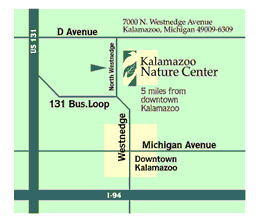 Beginning this weekend the Kalamazoo Nature Center will feature an art exhibition that includes images from the Colony Farm Orchard. The show, entitled “Sacred Trees,” includes prints by Ladislav R. Hanka and paintings and photography by Sniedze Rungis and Zaiga Minka Thorson. The opening is Sunday 7 February 1-3 P.M.
Beginning this weekend the Kalamazoo Nature Center will feature an art exhibition that includes images from the Colony Farm Orchard. The show, entitled “Sacred Trees,” includes prints by Ladislav R. Hanka and paintings and photography by Sniedze Rungis and Zaiga Minka Thorson. The opening is Sunday 7 February 1-3 P.M. The Herald correctly
The Herald correctly 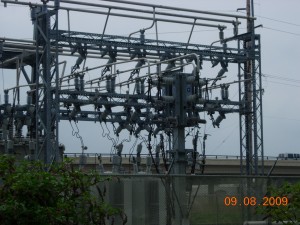
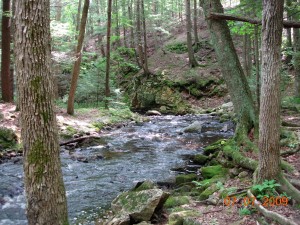
 The Kalamazoo Gazette for Wednesday 30 December 2009 had a front-page article with the headline “Bill to allow WMU business park expansion is on governor’s desk.” In it we learned that “WMU leaders hope to expand the Business Technology and Research Park to the 55-acre Colony Farm Orchard property….”
The Kalamazoo Gazette for Wednesday 30 December 2009 had a front-page article with the headline “Bill to allow WMU business park expansion is on governor’s desk.” In it we learned that “WMU leaders hope to expand the Business Technology and Research Park to the 55-acre Colony Farm Orchard property….” Based on WMU’s rhetoric, a restriction that the land be used to expand the BTR park was quite logical. Its quick disappearance is one line of evidence suggesting that WMU does not plan to use Orchard this way now, if it ever did.
Based on WMU’s rhetoric, a restriction that the land be used to expand the BTR park was quite logical. Its quick disappearance is one line of evidence suggesting that WMU does not plan to use Orchard this way now, if it ever did.